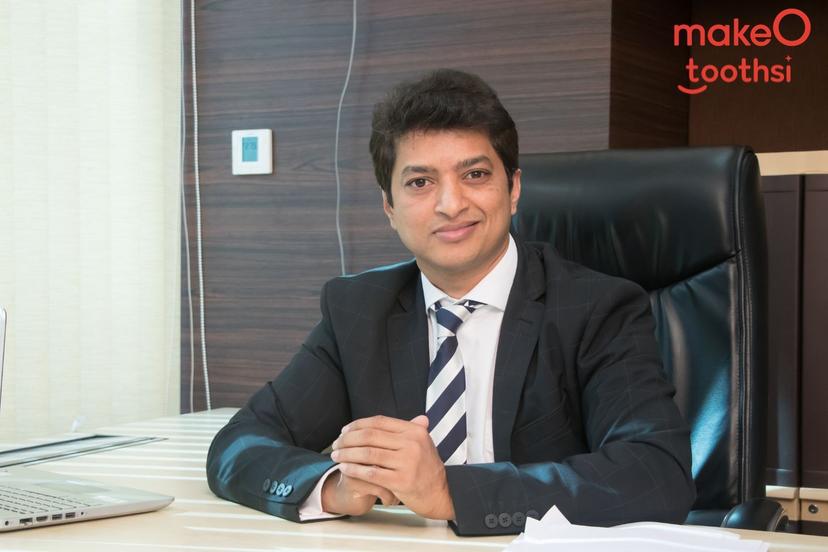MakeO blog
Gum Infections- Causes, Symptoms, and Treatment
You may go on about your regular life without a worry about your oral care and one day it can sneak up on you in the form of gum infections. Typically noticeable when you are facing bleeding or swollen gums and bad breath, gum infection is a serious oral infection that affects the gums and jaw. It makes chewing and talking painful and if left untreated, can lead to several serious complications. So if you have ever faced gum infections or want to prevent them, read on to find out the causes of gum infections, their symptoms, treatment options and precautionary tips.
Common Causes of Gum Infections
Gum infection commonly occurs due to the accumulation of bacteria in the tissues around the teeth. However, other causes can lead to tooth and gum infections as well. Below listed are some of the primary gum infection causes:
Poor dental hygiene practices: When you fail to follow a proper dental care routine, i.e., brushing and flossing, bacteria (that is present in your mouth) starts to accumulate leading to plaque and tartar buildup. In such cases, teeth cleaning becomes difficult and becomes a breeding ground for bacteria, resulting in gum infection.
Heredity: If you have a history of dental concerns in your family, then it can possibly contribute to the tooth and gum infections that you are suffering from.
Diabetes: When the sugar levels increase in your blood, the count becomes high in your saliva as well. If bacteria buildup is already in the process, those microorganisms would consume sugar (present in saliva) as food, causing tooth decay and gum infection.
Stress: When you are stressed it may alter your immune system, leading to periodontal disease.
Crooked teeth: Crooked or misaligned teeth pose a problem while brushing your teeth and cleaning them properly. These can further lead to plaque and tartar buildup, and make it difficult to maintain dental hygiene.
Medicinal effect: Some medicines including antihistamines and immunosuppressive medications can have a negative effect on gum health and cause gum diseases and infection.
Common Symptoms of Gum Infections
Following is a list of gum infection symptoms:
Red, puffy gums: During the early stages of gum infection, you may suffer from red, puffy gums.
Bleeding gums: Along with the redness and puffiness, you may also notice bleeding in the gums, especially while brushing.
Loosened teeth: Those suffering from gum infection may also notice loosened teeth.
Other than these, there are other gum infection symptoms including pain while chewing food, tooth sensitivity, bad breath, receding gum, misaligned teeth, and pus discharge in the mouth.
Types of Gum Infections
Below listed are several types of gum infections that indicate different stages:
Gingivitis: It is a mild form (early stage) of gum disease that causes swelling, redness, and irritation in the gums or gingiva.
Periodontitis: Refers to a severe gum infection that damages the soft tissue, and (if left untreated) affects the bone supporting the teeth.
Aggressive periodontitis: This is an advanced stage of periodontitis where gingival tissue, gingival ligaments (which hold your teeth in place), and bone destruction occur at an accelerated speed.
Chronic periodontitis: This type of gum infection results in the inflammation of the teeth’s gingival tissues and bone loss. Gum recession and gingival pockets are the primary symptoms of chronic periodontitis.
Systemic periodontitis: This type of gum infection occurs due to systemic conditions including diabetes, respiratory disease, etc.
Necrotizing periodontal disease: Refers to a condition where soft tissue (gums) and hard tissue (alveolar bone) both get destroyed. This condition can make it difficult to maintain oral hygiene.
Common Risk Factors
Some complications that may occur due to a gum infection are:
- The formation of pus (often very painful)
- Loose teeth
- Receding gums
- Loss of tooth
- Significant damage to the bone and tissue that connects the tooth to the jaw
When to see a dentist for periodontitis?
One of the first and major signs of periodontitis is if you feel your teeth loosen. And if you face any pain or discomfort while chewing, or speaking, notice swollen or bleeding gums, it is time for you to see a dentist to treat your problem. Only a dental professional can study your teeth and gums, diagnose your gum infection and help you treat it correctly. They may also advise you on some prevention tips to protect yourself from gum infections in the future.
What is the Best Treatment for Gum Infections?
Following is a list of gum infection treatments available that you can opt to get rid of gum infections:
- Professional deep teeth cleaning (in gum and teeth when plaque turns into tartar)
- Oral antibiotics (in case of severe or frequent gum infection)
- Surgery like bone or tissue grafting (in case of advanced gum infection)
Tips to Prevent Gum Infections
You can follow the tips listed below to prevent tooth and gum infections:
- Brush your teeth twice a day
- Floss your teeth at least once a day
- Swish your mouth with an antibacterial mouthwash
- Quit smoking
- Consume a balanced diet
Now that you know the causes, symptoms, and all the important details regarding gum infections, you can easily preserve your smile and maintain optimal dental health. In case you develop any dental issues, you can always opt for evaluation and treatment.
Oral care with makeO
We at makeO toothsi produce a holistic range of oral care products to help you with your dental woes. And if gum infections are your main concern, our electric toothbrush and water flosser should be on your list!
Not only is the toothsi electro a modern, sleek, toothbrush built for comfortable and long-lasting use, but it is also highly effective at cleaning food particles and germs from hard-to-reach nooks, thereby keeping your teeth away from infection. Our toothsi smart water flosser comes in as a secondary and excellent teeth-cleaning device that ensures to remove any remaining germs or particles in the teeth. Using these two products together will give you double the protection you need against gum infections!
And remember, poor dental health and issues like crooked or misaligned teeth can pave the way for gum infections. While for other severe dental issues, you can consult a dentist and opt for treatments like surgery (if needed), for crooked or misaligned teeth, there's an easier alternative or solution - invisible aligners. By opting for this advanced solution, you can eradicate the root cause of gum infection, and correct your teeth alignment effortlessly. If a comfortable and affordable teeth alignment process is your choice, then trust the makeO toothsi smile makeOver process and embrace invisible aligners.
Invisible aligners from makeO toothsi put gentle pressure on your gums and correct your teeth alignment within six months to two years, depending on the severity of the teeth’s position and the length of time you wear them. The smile makeOver process is comfortable (as you can remove invisible aligners anytime you want and consume food without much restriction) and super affordable as well. So, follow a proper dental care routine, treat misaligned teeth (if needed), and ward off gum infections.
FAQs on Gum Infection Treatment
1. What is one of the best treatments for gum infection?
Topical or oral antibiotics are considered to be one of the best treatments for gum infection as they help tackle bacterial infection.
2. Is gum infection serious?
If you notice redness or swelling in your teeth or gum, you must opt for treatment as these are signs of a gum infection and should be treated in order to avoid tooth loss and other health complications.
3. Is gum infection reversible?
Yes, gingivitis, the first stage of gum infection is reversible. By maintaining proper oral hygiene and professional dental cleanings, you can reverse the damage caused by gingivitis.
4. What health conditions are associated with gum infections?
Periodontal disease may increase the chances of developing diabetes, heart and lung disease, and causing a stroke.
5. What are the different teeth cleansing options available to cure gum infection?
Scaling (removing tartar from the gum line), root planing (smoothening the root of the tooth and removing plaque and tartar from it), and lasers are the different teeth cleansing options available to cure gum infection.
Related articles

Types of Braces: Removable vs Fixed Braces, Which is Right For You?

This Diwali, Smile Bright With makeO Teeth Whitening Kit

Dr. Pravin Shetty: Pioneer in Lingual Orthodontics & Innovative Smile Solutions
How do I Know I’m the Right Candidate for makeO toothsi Teeth Aligners?

